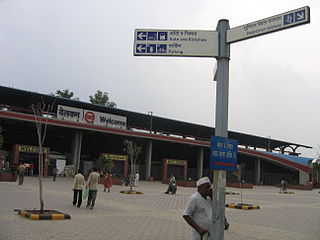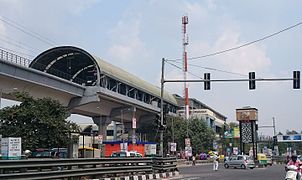
The Red Line is a metro rail line of the Delhi Metro, a rapid transit system in Delhi, India. It is mostly an elevated line and has 29 stations that runs from Rithala to Shaheed Sthal with a total distance of 34.55 km. The Tis Hazari – Shahdara section of this line was the first stretch of the Delhi Metro that was constructed and commissioned. The line connects the areas of Ghaziabad in Uttar Pradesh and the districts of Shahdara, Central Delhi and North West Delhi in Delhi.

The Yellow Line is a metro rail line of the Delhi Metro, a rapid transit system in Delhi, India. It consists of 37 stations from Samaypur Badli in Delhi to Millennium City Centre in the neighbouring city of Gurgaon in Haryana. The 49.02 kilometers (30.46 mi) line is mostly underground and laid under one of the most congested parts of Delhi. The Yellow Line is the second line of Delhi Metro to become operational after the Red Line.

Chhatarpur Temple is a temple dedicated to the goddess Katyayani. The entire complex of the temple is spread over a wide area of 28 hectares. It is located in Chhatarpur, on the southwestern outskirts of the New Delhi The temple was established in 1974, by Baba Sant Nagpal ji, who died in 1998. His samadhi shrine lies in the premises of the Shiv-Gauri Nageshwar Mandir within the temple complex.

Urban rail transit in India plays an important role in intracity transportation in the major cities which are highly populated. It consists of rapid transit, suburban rail, monorail, and tram systems.

Welcome is an important At-Grade interchange metro station on the East-West Corridor of Red Line and Elevated interchange metro station on the North-South Corridor of the Pink Line of the Delhi Metro. It was one of the first stations during the Phase 1 and Phase 3 of the Delhi metro. It is located a short walk away from Shyam Lal College, Delhi University.

The Millennium City Centre Gurugram is a terminal station on the Yellow Line of the Delhi Metro. It is an elevated station and is located in Gurgaon in the National Capital Region of India. The station was inaugurated on 21 June 2010 as part of the Qutab Minar—HUDA City Centre corridor.

The Hauz Khas metro station is an interchange station between the Yellow Line and the Magenta Line of the Delhi Metro. It serves Hauz Khas Enclave, Sarvapriya Vihar, Vijay Mandal Enclave, RBI colony, Mayfair Gardens and the IIT Delhi. The entrance to the station is located on Outer Ring Road, to the east of Aurobindo Marg and to the west of Khelgaon Marg.

Qutab Minar is an elevated station on the Yellow Line of the Delhi Metro. It was inaugurated on 21 June 2010 as part of the 14.47 km completely elevated corridor from Qutab Minar – HUDA City Centre. The station is close to the Qutb Minar and its monuments, a UNESCO World Heritage Site. Parking facilities are available. During peak hours, it serves as an alternate southern terminus for the yellow line along with Sultanpur.

Jasola Apollo is a Delhi Metro station in Delhi. It is located between Harkesh Nagar Okhla and Sarita Vihar stations on the Violet Line.

Kaushambi is an elevated metro station located on the branch line of the Blue Line of the Delhi Metro in Delhi. Built as part of a 2.57 km extension from Anand Vihar station, it was originally expected to open in March 2011. After multiple delays, the station finally opened on 14 July 2011, with 200 parking spaces to cater to commuters in the vicinity.

The Delhi Metro is a mass rapid transit system which serves Delhi and its adjoining satellite cities, such as Ghaziabad, Faridabad, Gurugram, Noida and Bahadurgarh, in the National Capital Region of India. The system consists of 10 colour-coded lines serving 256 stations, with a total length of 350.42 kilometres (217.74 mi). It is India's largest and busiest metro rail system and the second-oldest, after the Kolkata Metro. The metro has a mix of underground, at-grade, and elevated stations using broad-gauge and standard-gauge tracks. The metro makes over 4,300 trips daily.

Kishangarh is an Urban village. The Village is located near Vasant Kunj in South West Delhi district of Delhi, India, on the hills of Aravali, between Mehrauli and Vasant Kunj. One extreme of Kishangarh is around 4 km from Qutub Minar in historic Mehrauli area. The other extreme is approximately 7.5 km from the Indira Gandhi International Airport. Munirka is about 5 km, where the Aruna Asaf Ali Marg, connecting the main Vasant Kunj Marg with the Outer Ring Road forms its western boundary.

The Pink Line is a metro rail line of the Delhi Metro, a rapid transit system in Delhi, India. It consists of 38 metro stations from Majlis Park to Shiv Vihar, both in North Delhi.

The Dashrathpuri metro station opened on 29 May 2018 for public on the Magenta Line of the Delhi Metro. Dashrath Puri is part of Phase III of Delhi Metro.

The Sadar Bazaar Cantonment metro station is located on the Magenta Line of the Delhi Metro. It was opened to public on 29 May 2018.

The R. K. Puram metro station is located on the Magenta Line of the Delhi Metro.

The Sukhdev Vihar metro station is newly opened located on the Magenta Line of the Delhi Metro and situated at Sukhdev Vihar

The Jamia Millia Islamia metro station is located on the Magenta Line of the Delhi Metro which was inaugurated on 25 December 2017 by Prime Minister Narendra Modi.

The Okhla Vihar metro station is located on the Magenta Line of the Delhi Metro. It is located in Abul Fazal Enclave just behind Jamia Nagar Police station. This Metro station has three gates. One named as Abul Fazal Enclave Part-I another Hari Kothi Road and the last one as Jamia Nagar Police Station.
The Golden Line(Line 10) is an under-construction rapid transit line of the Delhi Metro. It will connect southern Delhi directly with Indira Gandhi International Airport to relieve the increasing traffic, congestion and pollution on roads. It will start from Terminal 1-IGI Airport, which was previously planned from Delhi Aerocity, and end in Tughlakabad. It will be 25.82 km (16.04 mi) long with 16 stations, out of which four will be elevated and 12 will be underground. Construction began on the line in June 2022, as part of the fourth phase of the Delhi Metro's development, and is expected to be completed by March 2026.
























